SEO for Lawyers is the practice of optimizing your content, website structure, and local rankings so it shows up in search engine results pages (SERPs) like Google and Bing – ideally on the first page.
The first step in implementing SEO for your law firm website is keyword research. This involves identifying search terms that potential clients, lawyers, and attorneys use to find your law firm.
When you’ve identified your target keywords, you’ll want to use them for search engine optimization to optimize your website content. This will help your website rank higher in search engine results pages through optimization, content marketing, links, and local SEO efforts.
You’ll also want to optimize your website for local search by applying local SEO strategies. This strategy includes making a Google Business Profile for your law firm’s location to improve search engine optimization and local SEO.
An SEO ranking factor for Google to rank websites in organic search is backlinks. This requires you to implement a link building strategy so other sites will link to your content for search engine optimization.
Checking your website’s technical performance is just as important as optimizing content and getting quality backlinks for search engine optimization. For this, you’ll need to conduct Technical SEO, which is a method of assessing your site’s speed, structure, and user-friendliness.
You can focus on using organic SEO, which means you’re not going to use paid search engine optimization methods. However, you can opt for paid SEO, also known as pay-per-click (PPC) ads, to boost your organic traffic on search engines. We’ll discuss organic SEO vs paid SEO later.
To help you understand search engine optimization (SEO) better, these are some basic terms, tools, and page you’ll need to learn to work.
Attorneys need SEO because it helps them establish an online presence, find potential clients, and grow their business. Ranking for highly competitive keywords in the legal industry can be a challenge, as attorneys and law firms are not skilled with implementing SEO campaigns.
Most law firms hire a law firm SEO agency to ensure they get the best possible results from their SEO efforts.
To succeed in SEO, lawyers need to gain at least a basic understanding of how search engine, page, and optimization work and how they contribute to an effective SEO campaign.
Keyword research is the process of identifying relevant keywords or search terms that people use to look for a business online. When you create content or optimize existing content with the right keywords on your page, you help have an increased chance of ranking higher in search engine results, which improves your online visibility and attracts potential clients.
You can start with a free tool like Google Keyword Planner to help with basic keyword research.
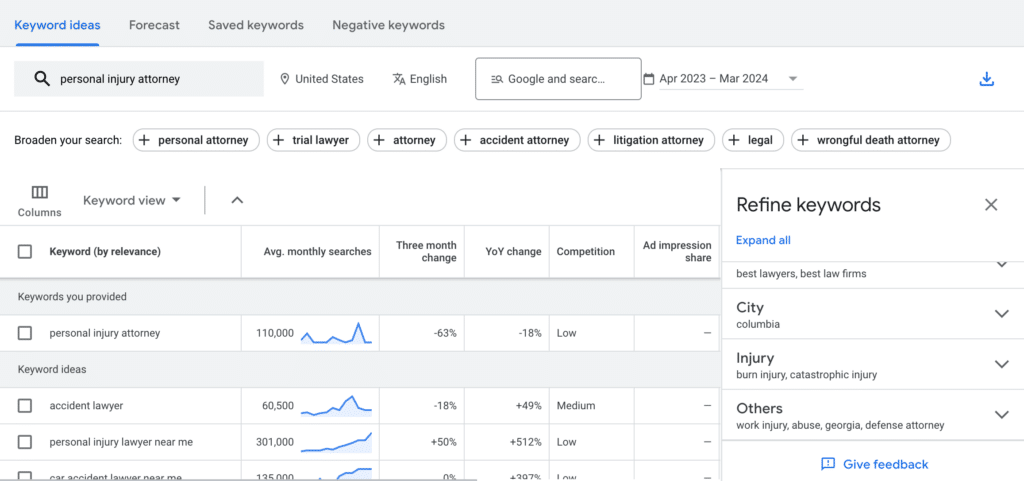
Paid SEO tools like Ahrefs can help search engine provide more comprehensive data that enables you to make more effective keyword strategies.
After identifying relevant keywords during keyword research, the next step is to create high-quality content around these keywords. Every content created for your law firm website must be strategic and intended to boost your Google ranking and drive website traffic that generate leads and new clients.
Content optimization for a legal website, including blog posts, landing pages, case studies, FAQ pages, service pages, and even the contact us page, will apply to all types of content within the site for search engine visibility.
Link building is part of an SEO method called Off-page SEO (also called off-site SEO), and it is done by getting other websites to link to your website content (called backlinks) which results in referral traffic.
Ideally, the referring site should have high domain rating (DR) which is a metric that measures a backlink’s quality. Getting backlinks from high DR sites should be a main goal for any link building campaign as it can boost your search engine ranking while establishing your website as a trusted source of information.
If your firm is a local business, then it makes sense to optimize for local SEO. Local SEO for attorneys involves creating business listings in Google My Business (GMB) and other online legal directories.
With optimized listings, law firms can rank and appear in the local 3-pack, which makes them visible to potential clients searching for law firms near their area.
Below are the law firms in the local 3-pack position that shows up for the keyword “personal injury attorney ny”:
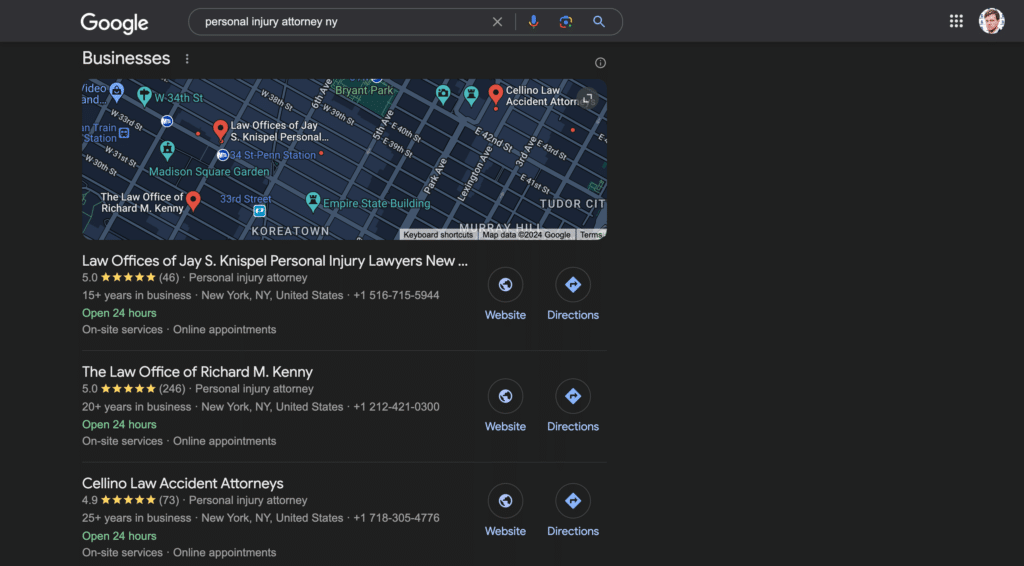
Checking the technical SEO for law firms websites is important because it helps search engines crawl and index sites correctly while providing the best possible user experience. Technical SEO for law firms involves optimizing their website for speed, site structure, HTML code, internal linking, and mobile-friendliness – all are part of Google’s SEO ranking factors.
Organic SEO is when you optimize your website so it ranks in search engine results pages, but without using paid methods. Content that appears in SERPs using organic SEO are called organic results and visits to a website are called organic traffic. This is achieved by content marketing, acquiring backlinks, and improving the site’s technical aspects.
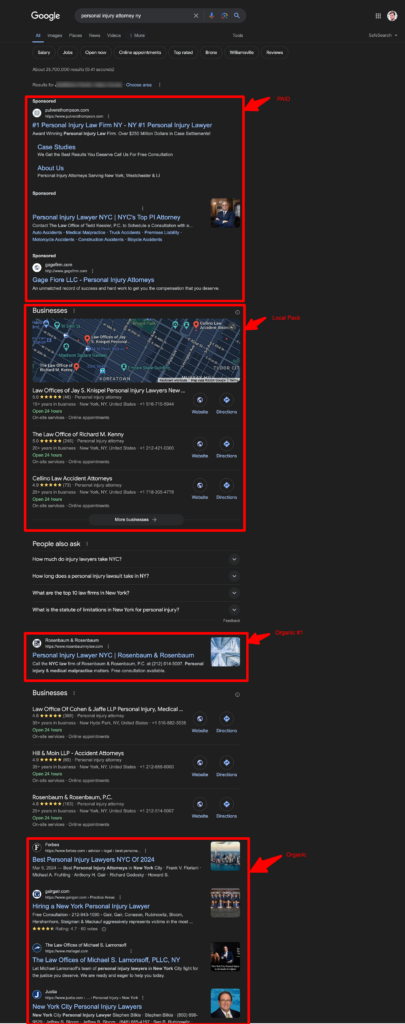
Paid SEO involves investing in digital ads, also known as pay-per-click (PPC) ads, that appear on top of organic search results. You pay a specific amount every time someone clicks on your PPC ads. PPC is a good way to track and measure conversions while getting faster results than organic SEO.
If you haven’t done a legal SEO campaign for your website, here’s how you can start:
There are two common ways to check if Google’s algorithm recognizes your website:
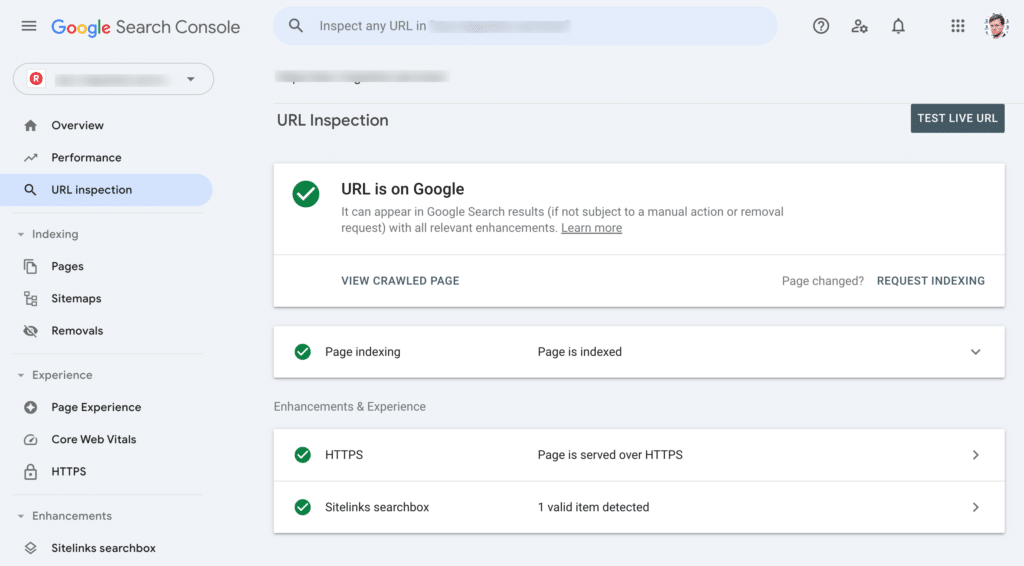
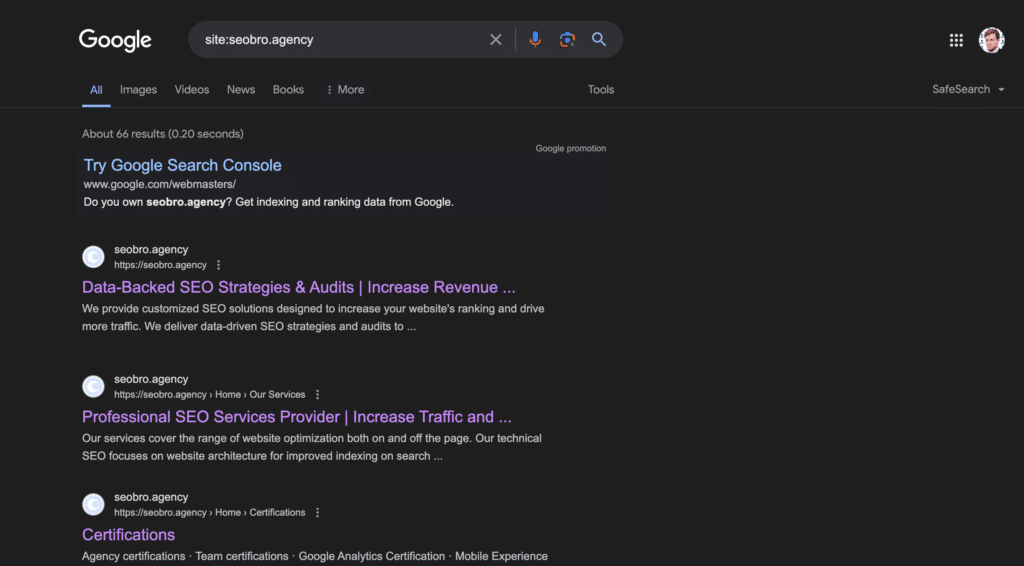
If you don’t see your law firm’s website using any of these methods, it means your site is not indexed. Ensure that you submit your sitemap to Google Search Console and check for technical errors on your site to fix this issue.
If you’re not sure how to proceed, it’s best to hire a SEO agency so your website is properly diagnosed and improved by experienced SEO specialists.
Optimizing your website is one of the top attorney SEO strategies you can do. In this particular strategy, it’s not just written content on the site that needs to be optimized. You also need to optimize other website elements like images and meta descriptions (title tags, subheadings, alt-text, etc.)
Ensure that every content you create on your site – blog posts, service pages, FAQ pages – have relevant keywords that will potentially increase their Google rank.
A best practice for SEO success is to use long-tail keywords, which are keywords that have a unique qualifier, to show up on highly-specific search queries.
For instance, instead of using “personal injury attorneys” as your keywords, you can be more specific and use “NEW YORK personal injury attorneys,” to target potential clients in your area and show up in local search results.
Below is an example from New York-based personal injury law firm Rosenbaum & Rosenbaum P.C..
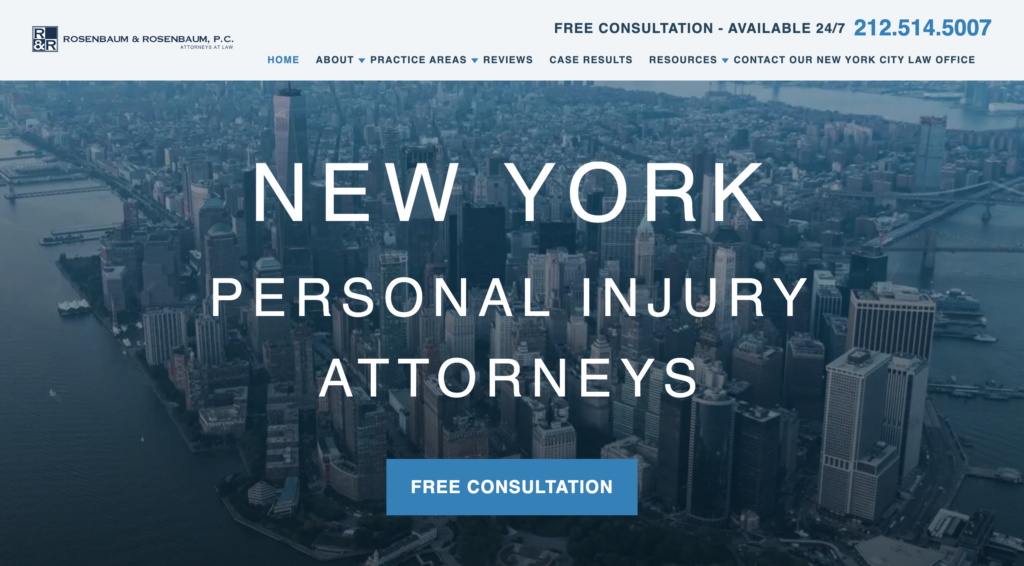
Images uploaded to your site need to be optimized. Here are some ways you can do this:
Using relevant and specific keywords and incorporating them to your content is a vital part of your lawyer SEO strategy.
Think of your audience and the questions they might have about your legal services. If you are a personal injury firm in Miami, some keywords you might want to target are “New York personal injury firm,” “car accident lawyer in New York,” and so on.
A meta description is the text that appears below your website’s title in SERPs. They summarize what the web page is about and can be the deciding factor for a searcher to click on the link or not.
Meta descriptions help your content rank in search engine results pages and also increase your click-through rate (CTR). When you have a short but compelling meta description, people are more likely to click and visit your site.

Avoid keyword stuffing your meta descriptions as this might hurt your SEO. Focus on making your meta description unique, clear, and concise. Also include a call-to-action (CTA) such as “Learn more” or “Get expert help now” to make it more compelling.
Creating content for your website should mean that you are satisfying what people want to read (or watch) about your niche. For lawyers, this means creating content about their practice area and sharing helpful information that helps people navigate a legal situation.
To create SEO-focused content, you’ll need to conduct keyword research and identify a few keywords you want to target for your website.
You can use a free resource like Google Keyword Planner or a paid tool like Ahrefs to check a keyword’s metrics such as search volume, competition, and keyword difficulty.
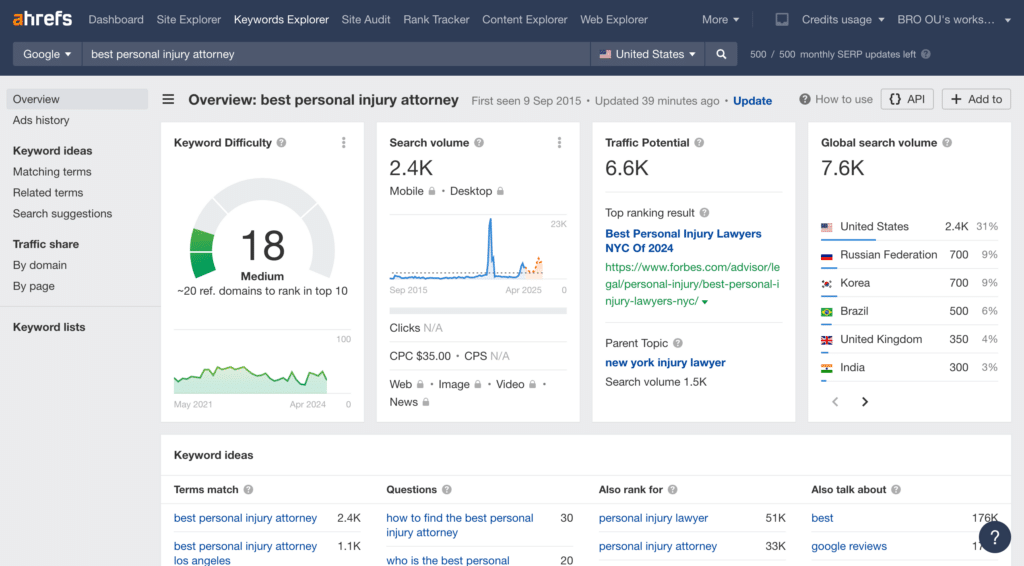
Incorporating the right keywords to your website’s content, including page titles, headings, and subheadings can greatly improve you on-page SEO.
These are web pages that are specifically about your area or areas of practice. For instance, if you practice family law, you can have separate practice pages for Divorce, Adoption, and Custody.
From the Practice Areas menu in the header section of Rosenbaum & Rosenbaum P.C.’s website, it’s clear that their practice area is personal injury.

Here’s the FAQ page for personal injury law firm Goldberg Sager & Associates:
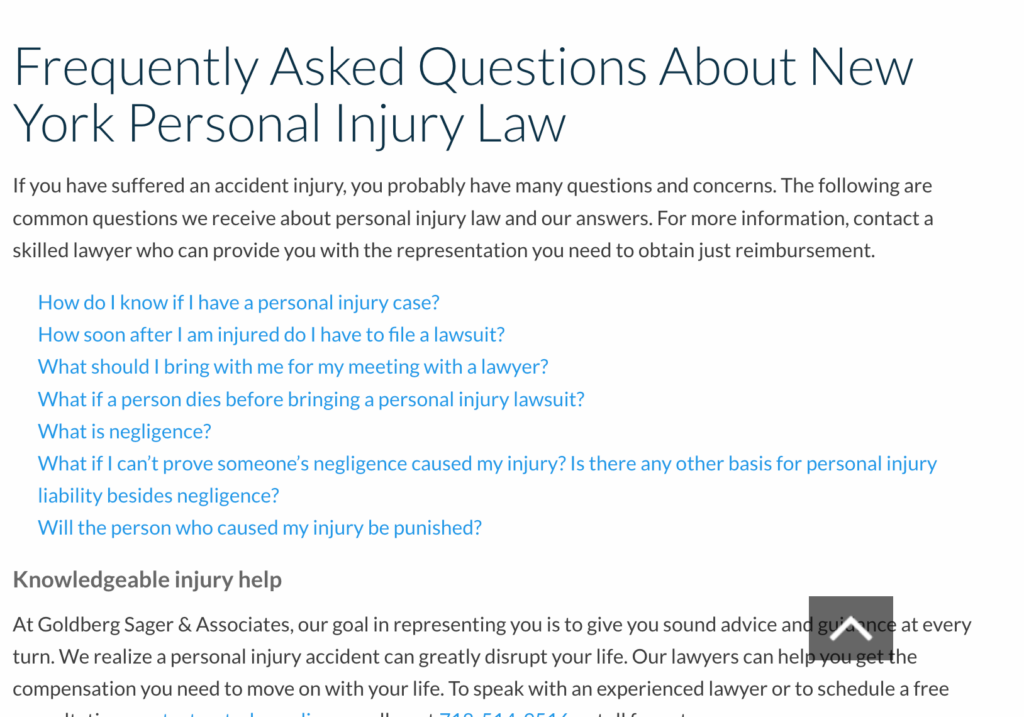
SEO does not end with having a keyword-optimized website. You also need to ensure that your website’s technical aspects are in great working condition and that your website visitors have the best possible user experience when browsing your site.
Here are some areas where technical SEO is applied:
According to experts, the acceptable load time for a website or web page is 2-3 seconds. Anything longer and there’s a big chance that the user will leave the site. Google looks at site speed as part of Core Web Vitals, which are a set of standards for ranking websites in Search.
You can use Google’s PageSpeed Insights tool to check your website speed. Simply go to the site, enter your law firm website’s URL, and click Analyze.
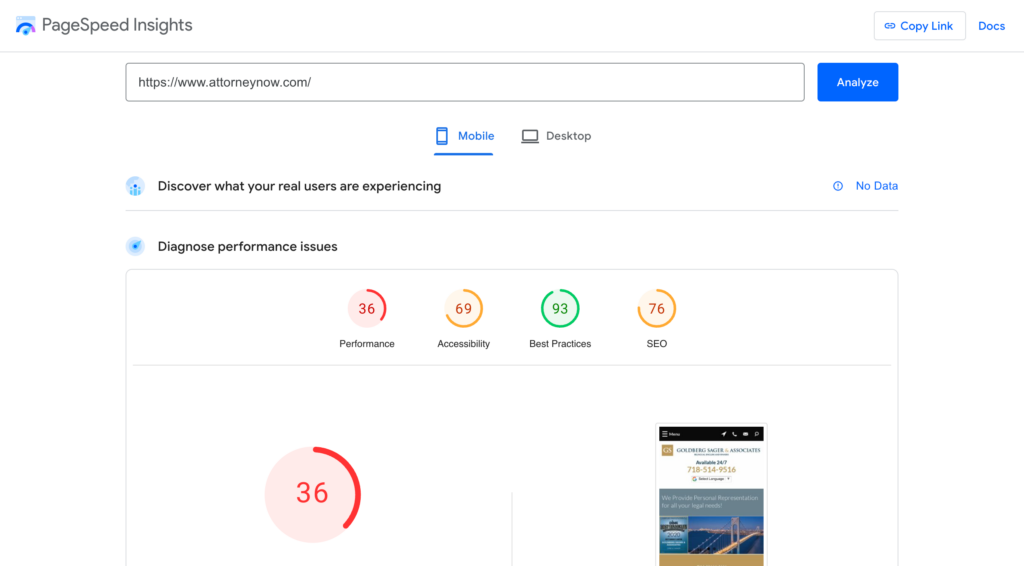
Your site should have a clear hierarchical structure, and pages like the homepage, parent pages, and child pages should be organized in a way that makes sense for Google’s search bots. Having a good site structure helps your site rank in Google search results, get more traffic, and provide a better user experience for your prospective clients.
You can hire a Technical SEO expert to create schema markups for your website. Schema markup is a code that is added to a website so it displays rich snippets in SERPs. Rich snippets show website information like ratings, reviews, and pricing details.
Here’s what a search result might look like when using schema markup:
Your law firm should be mobile-friendly, which means it should be able to look great on mobile devices, which can be achieved with a responsive design, fast loading speed, readable fonts and buttons, and easy-to-navigate layout.
An example of a mobile-friendly web design would be this website for Pro Accident Lawyers:
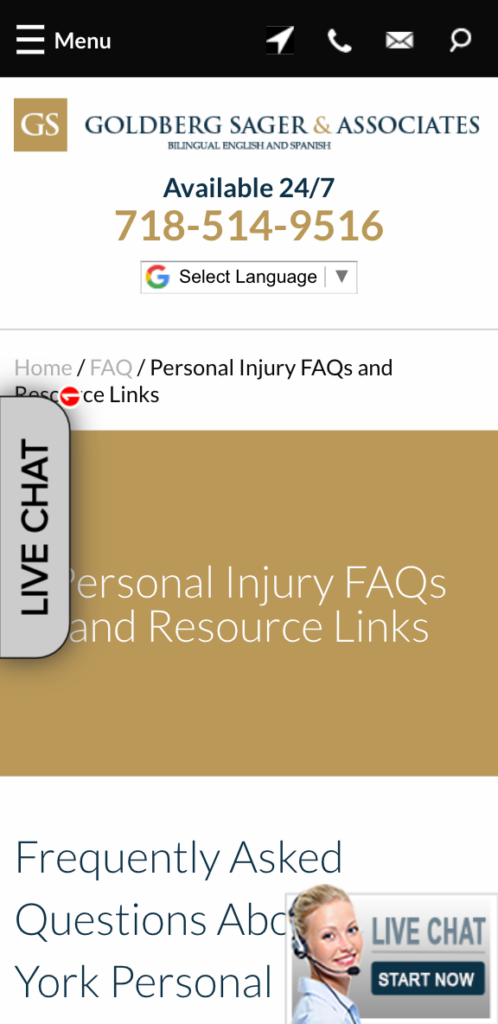
Your law firm’s website design should be easy to use. To do this, you’ll need to focus on creating a website that have the following:
Rosenbaum & Rosenbaum P.C., achieved a simple, cohesive look for their law firm website while making sure that it’s easy to use.
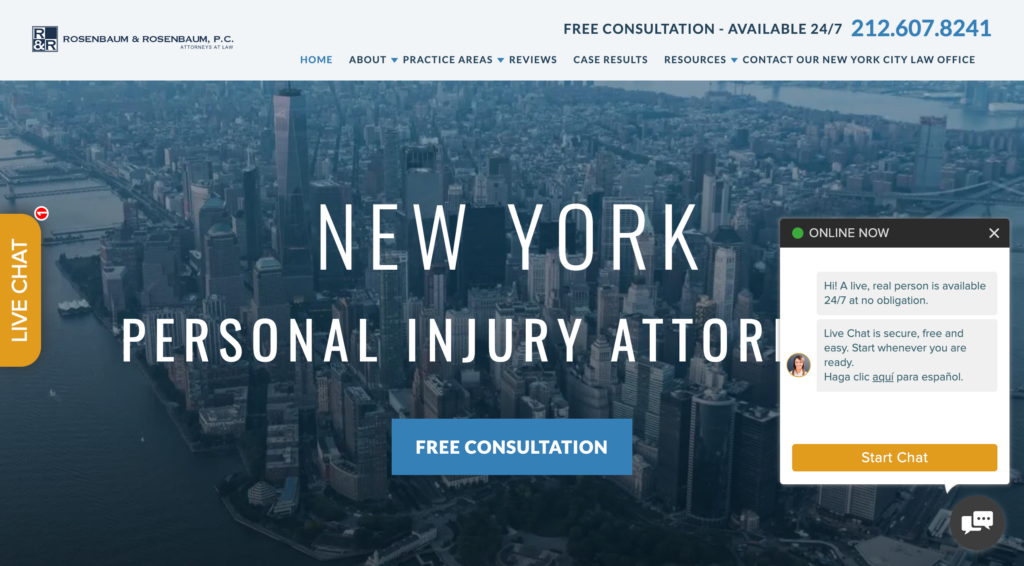
When you get these technical aspects working, you have better chances of ranking in SERPs and achieving your SEO goal.
Creating business listings for your law firm in legal directories helps you establish authority for your firm while increasing your online presence. Find the best legal directories to list your firm and make sure you enter your business information (name, phone number, address, website) correctly and consistently with your other online listings.
Sites like Avvo, Lawyer.com, Nolo, and Justia are all reputable directories for lawyers and law firms in all practice areas.
Having your law firm listed in these directories helps increase your chances of getting discovered by potential clients, and building your credibility online. It’s also a great way to improve your SEO as these domains have already built high authority which search engines trust. Some legal directories show review ratings, so if you have lots of positive reviews, this is a great platform to showcase that.
Link building is an important but often overlooked aspect of SEO and legal marketing in general. Having quality backlinks from reputable websites is one of the main ranking factors for search engines like Google.
The most common methods of link building outreach can involve pitching articles to publications, signing up as a source for journalists, writing guest posts on other websites, and creating useful content that gets shared by other websites.
Below is an example of personal injury lawyer Domenic Sanginiti, Jr. writing for Lexblog and getting a link to his law firm’s website.
After putting a lot of effort into SEO campaigns for your marketing strategy, you need to know which strategies are working and which ones need improvement.
Google Analytics
Marketers use Google Analytics to measure website performance. This free tool measures website metrics like website visitors, page views, unique visitors, conversion rate, and bounce rate.
Ahrefs
Ahrefs is a paid SEO tool that provides insight on keyword ranking and performance. It can track the target keywords for a specific website and show its rank in SERPs. It also provides data on metrics like keyword ranking, organic vs paid traffic, backlinks, and PPC performance.
Hootsuite
Hootsuite is a social media management platform that can track social media metrics like likes, shares, followers, and comments. Users can also schedule their social media posts in advance using this tool.
Delving into SEO for the first time can be overwhelming for lawyers and law firms. While it can be learned, most law firms are not likely to implement the best attorney SEO campaigns on the first try.
The most viable solution would be to get expert help from a Law Firm SEO company with relevant experience and proven strategies that delivered results.
Here at On The Map, we help law firms get started with their SEO strategy and achieve their business goals. Whether it’s ranking on search engines or increasing online visibility to a specific target audience, our SEO services give you a customized solution for best results.
Get in touch with us today and start using SEO to grow your law firm.